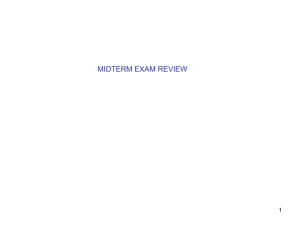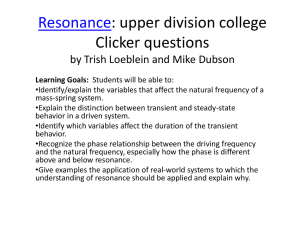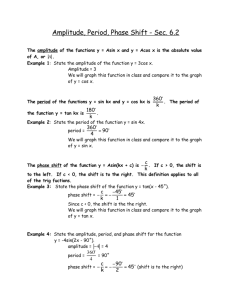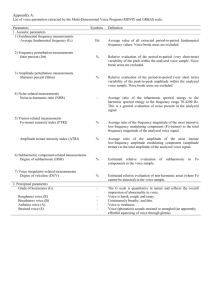Experiment 4: Harmonic Motion Analysis ( ) ( )
advertisement
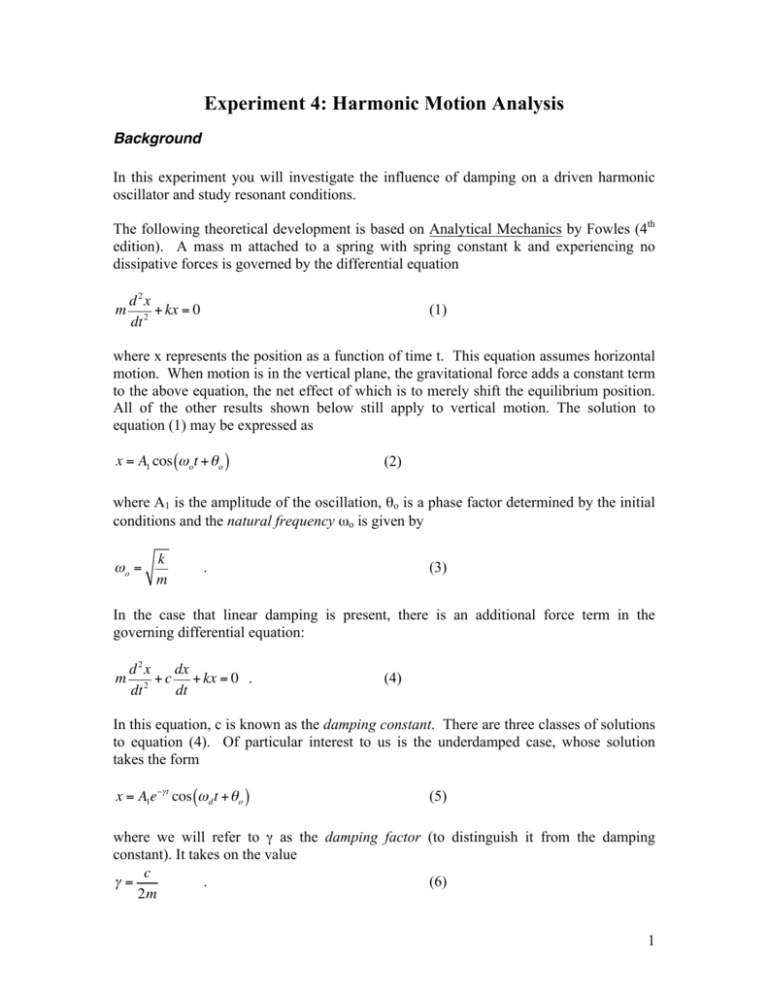
Experiment 4: Harmonic Motion Analysis Background In this experiment you will investigate the influence of damping on a driven harmonic oscillator and study resonant conditions. The following theoretical development is based on Analytical Mechanics by Fowles (4th edition). A mass m attached to a spring with spring constant k and experiencing no dissipative forces is governed by the differential equation m d2x + kx = 0 dt 2 (1) where x represents the position as a function of time t. This equation assumes horizontal motion. When motion is in the vertical plane, the gravitational force adds a constant term to the above equation, the net effect of which is to merely shift the equilibrium position. All of the other results shown below still apply to vertical motion. The solution to equation (1) may be expressed as x = A1 cos (ω ot + θ o ) (2) where A1 is the amplitude of the oscillation, θo is a phase factor determined by the initial conditions and the natural frequency ωo is given by ωo = k m . (3) In the case that linear damping is present, there is an additional force term in the governing differential equation: d2x dx m 2 + c + kx = 0 . dt dt (4) In this equation, c is known as the damping constant. There are three classes of solutions to equation (4). Of particular interest to us is the underdamped case, whose solution takes the form x = A1e−γ t cos (ω d t + θ o ) (5) where we will refer to γ as the damping factor (to distinguish it from the damping constant). It takes on the value c . (6) γ= 2m 1 Even though the motion strictly speaking is no longer periodic (the amplitude is decaying), ωd is still interpreted as an oscillation frequency. It is given by ω d = ω o2 − γ 2 . (7) Note that if we were to measure the amplitude of a decaying oscillation on 2 occasions, separated by n cycles, the ratio of those amplitudes, according to equation (5), would be Ao = eγ nTd An (8) where Td = 2π ωd . (9) and Ao is the initial amplitude reading while An is the amplitude reading n cycles later. Finally, suppose we apply a periodic driving force to the oscillator. We can do this through a periodic displacement of one end of the spring. A periodic displacement of the form Adrive cos (ω t ) will produce a force kAdrive cos (ω t ) , resulting in an equation of motion m d2x dx + c + kx = kAdrive cos (ω t ) 2 dt dt . (10) The solution to this equation contains a decaying portion that vanishes once the oscillation reaches steady state. The steady state portion is (11) x = A cos (ω t + φ ) where kAdrive A= 2 2 (12) (k − mω ) +c ω cω k − mω 2 . 2 2 and tan φ = (13) When the drive frequency ω is adjusted so that the amplitude is maximized, we say that 2 resonance has been achieved. The resonant frequency is given by ω r = ω o2 − 2γ 2 (14) It is left as an exercise to the reader to show both of the following (and you will need to derive this in your introduction:) when ω = ω o then φ = 90 o (15) and at resonance for a weakly damped oscillator ω Adrive ω Adrive = . (16) c 2γ m A word of caution: there are four different frequencies used to describe the damped, driven oscillator: ω, ωo, ωd, ωr. Make sure you understand the difference between these frequencies. Ares ≈ Procedure: Apparatus: Pasco Driven Harmonic Motion Analyzer 1. The apparatus should already be set up as indicated in Figure 1 of the equipment manual in the lab, using a red spring. D0 NOT TAKE THE HANGING BARS OFF THE SPRING. IT IS NOT NECESSARY TO MEASURE THEIR MASS. Rotate the screws holding the two cylindrical damping magnets so that they are as far from the metal damping rod as possible. 2. Move the device to a position that makes it easy for you to acquire data and then carefully follow the alignment procedure indicated on page 4 of the apparatus manual next to the device (follow both steps one and two). If this is not done correctly, your subsequent measurements will not be reliable. 3. You will now determine the resonant frequency (at least approximately) three different ways: A. With the drive motor off, set the function switch period. centimeter or two and release. Note the value of the period. Pull the rod down a B. The drive amplitude Adrive has been set. Do not adjust this setting. (see Figures 9 and 11 in the equipment manual). Turn on the drive motor and set the function switch to amplitude. Vary the drive frequency until the amplitude is a maximum. The resonant frequency can now be read by turning the function switch back to frequency. (If the oscillations are too violent, you can move the magnets in slightly to reduce the oscillation amplitude.) Two observations of note: First, every time you adjust the drive frequency, you need to wait a bit for steady state to be achieved. You are in fact observing the decay 3 of the transient portion of the solution discussed between equations (10) and (11). Second, when you are in resonance, you will see that a very small oscillation produced by the driving motor at the top of the spring produces very large oscillations in the mass bar at the bottom of the spring. This is the essence of the resonant phenomenon: all the drive force needs to do is to restore the energy lost due to damping in order to maintain these large oscillations. This is why the size of the damping is determined by the ratio between the drive amplitude and the resonant amplitude, as equation (16) predicts. C. Vary the drive frequency until the phase indicator reads a lag of 90o. When I did this, the LED did not start flashing until the oscillations had settled down to a steady state. In all three of these methods you should obtain approximately the same answer, but in principle (if you could measure accurately enough) not exactly the same answer. The first frequency you measured was 1/Td=fd= ωd/2π, and the third was fo=ωo/2π. The second was the true resonant frequency. Be sure to explain in your report why these are in fact the frequencies you measured. 4. In the following steps, you will measure the damping factor γ as a function of magnetrod separation. First, repeat your alignment process of step 2. Then, with the drive motor off, check that the magnets are retracted as far as possible and set the function switch to amplitude. A. Pull the rod down as far as practical without going past the point at which measurements can be made. B. Release the rod and remember the first reliable amplitude measurement. For the measurement to be reliable, you need to make sure the spring is always under some tension (i.e., it never goes slack). I think you will find that you need to keep the peak-topeak amplitude less than about 110 mm to achieve this. Also, to make sure that the oscillator is experiencing primarily magnetic damping, it is important that you minimize the amount of rubbing between the mass bar and the mass bar guide (where the LED is). That is why alignment is important in this part and why it is also important to pull the mass bar down as vertically as possible before you release it. C. Note the amplitude exactly three full cycles after your first reading. Record both the initial amplitude (step B) and the final amplitude (step C). While we often repeat a measurement several times to check the reliability, you do not need to repeat this one (nor those in D, E below). I do not want to bury you in data in this lab. Moreover, the reliability check will come when you compare your value for the damping factor as determined by C, D, and E. They should give you the same result. The fact that they won’t gives you a natural way to estimate the uncertainty in the damping factor. D. Repeat steps A-C but wait five cycles instead of three. Hint: every once in a while a student will shortchange the cycle count by one. Remember that if you are counting to yourself, when you read the value of Ao, you should count that as zero, the next amplitude update is at the end of the first cycle and so on. 4 E. Repeat steps A-C, waiting ten cycles this time. 5. With the help of equation (8), you now have enough information to determine the damping factor. The apparatus has measured the time dependent amplitude to the sine function (actually twice that value since it reads peak to peak). You have two separate readings separated by a known time (n cycles where you know the time it takes to complete each cycle). Note that each of the three trials above should give you a value of the damping factor and ideally, all three should be the same. 6. Measure the distance between the magnets using calipers. Then, move both magnets in by turning each one, one complete revolution. A small piece of tape should be on the magnet to help guide you. Turning one magnet one complete revolution moves it in 0.130 +/- 0.005 cm. Now repeat steps 4A-E. Continue moving the magnets in one complete turn each, making a complete set of measurements each time, until you have data for 5 different magnet separations. This will give you γ as a function of magnet-rod distance, which you should plot in your report. In your report you should discuss qualitatively the physics behind this damping mechanism and why you would expect the plot of γ vs. magnet distance to look as it does. 7. In this final step, you will measure the distance dependence of the damping constant by looking at driven oscillations. The drive amplitude, Adrive , has been set to 1.15 +/- 0.10 mm. Do not try to adjust the drive amplitude. Start with the magnets all the way out. Turn the drive motor on and make sure you are still in resonance. After waiting until the oscillations have reached a steady state, record the peak-to-peak amplitude of oscillation of the hanging mass using the amplitude setting on the apparatus. (Note that your raw data is the peak-to-peak amplitude. In your calculations you will need to divide this by 2 to get Ares.) Repeat this process for all of the magnet separations used in step 4 above. This amplitude, along with equation (16) above, will allow you to solve for γ. Compare these results graphically with those of steps 4-6 by displaying this data on the same plot. 8. Make sure that the drive motor is turned off and that the power switch on the back is turned off. 5 What is due: You should write up all of the sections for this report, including an Introduction and a Conclusion for the first time. In the Introduction, you should not repeat word for word what I have written as an introduction to this portion of the lab manual. However, you do need to make sure that each equation you will use to analyze your data appears in your Introduction (not all of them appear in what I have written), the physics behind each equation is clear, and each symbol in the equation is clearly defined. It is often helpful to show the origins of the equation (for instance, you could set up F=ma for the system in this case) and then skip to the solution or solutions that you will need, indicating any approximations that might have been made along the way. Number your equations for easy reference. Keep in mind that you are writing this report for someone with your background in physics but who has not taken this lab course. Use that as a guide in determining how much detail to provide and how many terms to define. Also remember to write the report as if your reader does not have access to the lab manual. That is, you should make your lab report self-contained, without references to the lab manual. Be sure to write the Introduction, as much as possible, from a general perspective. That is, avoid making references to details of the apparatus because you are assuming your reader has not yet been in the lab and hence does not yet know anything about the apparatus. The apparatus is properly introduced in the Procedure section. If you go back and look at how I wrote the theory section of this experiment, you will see it is understandable even if you do not know anything about the Pasco apparatus that you used in the experiment. It is important in your Conclusion that you make a connection with the objectives you stated in your Introduction. This will also serve as a reminder to make explicit in your Introduction what your objectives are! Your Introduction might contain a statement towards the end such as, “The objective is to verify equations 7 and 9 described above,” or “The objective is to measure property X.” If you are measuring property X by multiple, independent methods, then one measure of success in your experiment is that the multiple methods produce identical results, to within expected uncertainties. Remember, “close” is a subjective judgment, and reports should be objective wherever possible. Thus, you should not be concluding the various methods were close (or not close) but rather you should be commenting on whether were they within expected uncertainties. If they were within expected uncertainties, then you can go on to discuss how the experiment might be improved to reduce the uncertainties. If they were not within expected uncertainties, then you can suggest why that might be. Perhaps, for instance, the equation used to model the system did not really capture all of the important features of the apparatus you actually used, or perhaps the analysis of the model equation required too many approximations. Finally, pay careful attention to notes I made on your previous write-ups. If you have any questions about my comments, please ask. I do not intend this to be a game of “Try And Guess What The Instructor Is Really Looking For.” My goal is to spell out exactly what components are necessary to write a good report for this course. 6


